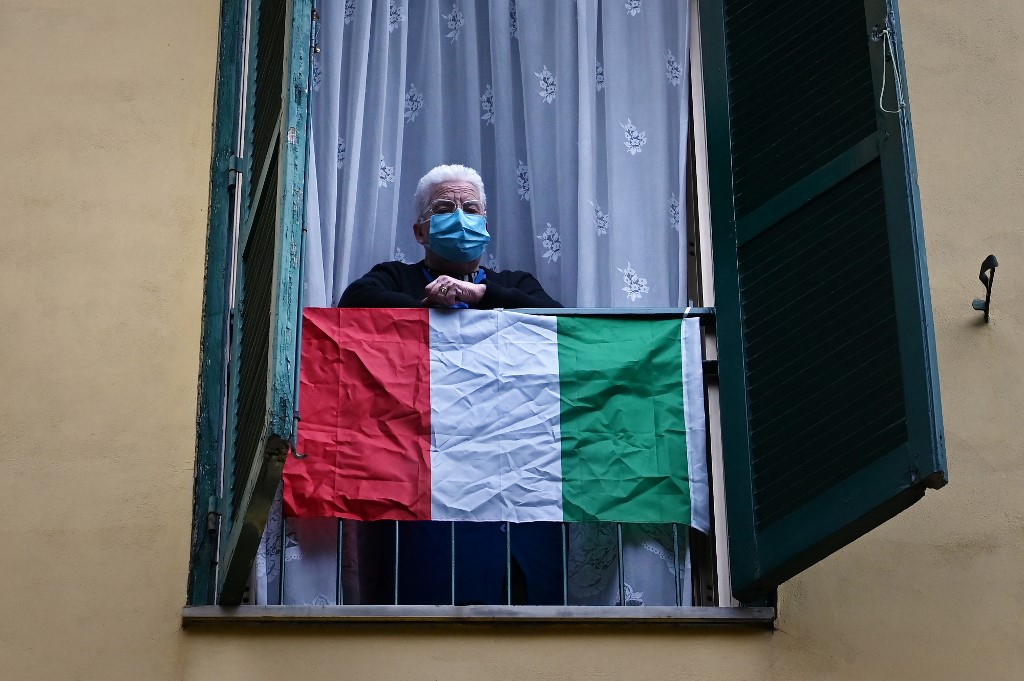Italy’s current coronavirus cases fall for first time

An elderly wearing a face mask stands behind an Italian national flag as artists perform in the courtyard of a popular apartment building for the show Sotto lo Stesso Cielo tour (Under the Same Sky tour) in San Basilio suburbs of Rome on April 18, 2020, during the country’s lockdown aimed at stopping the spread of the COVID-19 (new coronavirus) pandemic. (Photo by Alberto PIZZOLI / AFP)
Italy reported its first drop on Monday in the number of people currently suffering from the novel coronavirus since it recorded its first infection in February.
Those receiving intensive care treatment also fell to the lowest level in a month as Europe’s hardest-hit country began to see the first direct health benefits of its economically devastating lockdown.
The civil protection service said 108,237 people were either being treated in a hospital or were recovering at home after testing positive — 20 fewer than the total reported on Sunday.
“For the first time, we have seen a new positive development: the number of currently positive has declined,” civil protection service chief Angelo Borrelli told reporters.
“The number in intensive care is the lowest it has been in a month,” he added.
Article continues after this advertisementThe Mediterranean country’s death toll still rose by 454 to 24,114 — second only to the United States.
Article continues after this advertisementHowever, the figures are widely regarded as benchmarks rather than actual tallies — most Italian doctors believe the numbers of deaths and infections are far higher than those officially reported.
Those who died at home or in care facilities are not included and some of the hardest-hit regions have only been testing the sickest patients.
Some experts believe the true extent of the damage caused by the pandemic will be revealed in the number of excess deaths registered in the past few months.
In northern Italy, where the outbreak first exploded, some provinces have seen their usual number of deaths over a single month increase by a factor of four or five even when the official virus tolls were relatively small.
But the decline in the number of current official cases still marks an important data point in Italy’s calculation of what restrictions to lift and which to extend when the current lockdown expires on May 4.
Psychological tests
The economic and psychological toll of Italy’s six-week lockdown has also been hard to quantify.
An estimate released over the weekend said half of Italy’s official workforce of 23 million have sought government aid because they were either furloughed or unemployed.
Scientists are reportedly pushing the government to conduct psychological tests on a sample of the population to determine how long people can stay confined to their homes.
The Corriere della Sera newspaper said Prime Minister Giuseppe Conte will announce a new set of social guidelines this week that could include the tests.
Italy entered into a progressively more restrictive lockdown over the first half of March that has since been replicated by most European nations.
Its 60 million citizens have been barred from walking more than 200 meters (650 feet) from their homes without a significant reason.
Reports of domestic abuse have surged and scientists worry about the impact of such isolation on the elderly and the more vulnerable.
Conte’s government is now debating how it can lift the stay-at-home order and reopen businesses while there is still no coronavirus cure or vaccine.
Some regions took the incremental step of opening bookshops on Monday to see how social distancing measures can be safely applied.
For more news about the novel coronavirus click here.
What you need to know about Coronavirus.
For more information on COVID-19, call the DOH Hotline: (02) 86517800 local 1149/1150.
The Inquirer Foundation supports our healthcare frontliners and is still accepting cash donations to be deposited at Banco de Oro (BDO) current account #007960018860 or donate through PayMaya using this link.